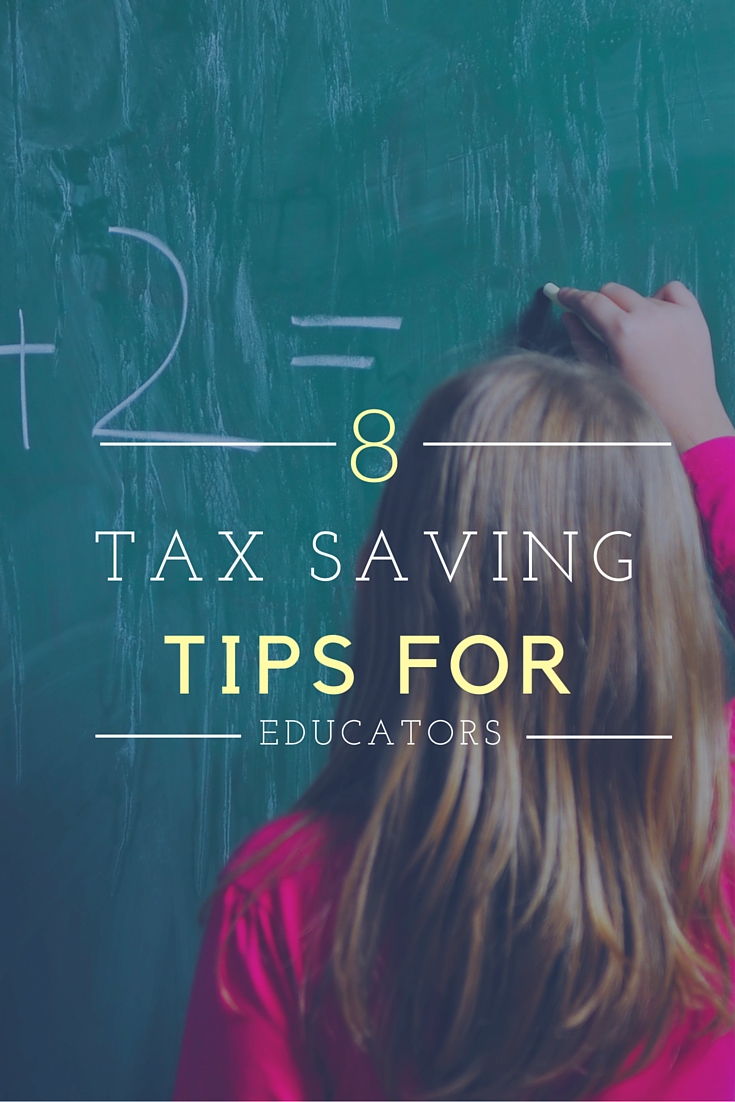With tax season upon us, you may be crunching numbers, collecting tax documents, and wondering about a possible refund.
There are a few ways for you as a teacher to potentially receive even more of a tax refund! Learn how with these 8 Tax Saving Tips for Educators.
1) Educator Expense Deduction
Educators who teach kindergarten through twelfth grade and work at least 900 hours a year at a school providing elementary or secondary education can use the $250 deduction for unreimbursed expenses. Married educators can deduct $500 for these expenses, using $250 individually.
Who exactly can use the deduction? Any of the following as long as they meet the school and 900-hour requirement.
- Teachers
- Counselors
- Instructor
- Principal
- Aide
Expenses include books, supplies, and computer equipment used in the classroom. Some restrictions apply to the deduction and decrease the amount an educator may take. An example is taking tax-free withdrawals from Coverdell education savings accounts.
2) Income Outside of School
Anytime you make income outside of your W2, you have to report the income yourself. This “self-employed” income is subject to taxation and can incur a penalty if you’re not withholding enough or paying it throughout the year.
If you have a side hustle or even tutoring in the summer where the check is made out personally to you, you need to be either withholding more tax on your teacher’s salary to cover the tax for your side project or you can set up quarterly payments.
Working with your tax professional can help you set up the correct amount with either strategy.
3) Continuing Education
If you take courses that you cover the costs for personally, you can deduct up to $2000 a year. This amount may differ in higher income brackets. While this is not yet a permanent deduction, the Compromise Tax Bill was renewed for 2015 and 2016.
This deduction is an above-the-line credit meaning it decreases your overall adjusted overall income that is taxable. This helps about other deductions dependent on your AGI as an added bonus.
4) Charitable Donations
Throughout the year, you may be asked for many donations as a teacher well-known in the community. Be sure to keep record of these as they do add up. This is an itemized deduction on your tax return. If you have other deductions like mortgage interest and other itemized items, this category is a good one to keep up with.
Also, if you buy anything that you donate to your school, these can become a charitable donation as well.
5) Working Parents Deduction
While you’re educating the young minds of the future, someone may be educating or watching over your even younger mind of the future.
Whether using a babysitter, nursery, day care, or preschool for childcare, working parents can get a certain amount depending on income and age of the child. Keeping receipt of these expenses can help get you a larger refund.
6) Student Loan Interest Deduction
If you have lingering debt and interest payments, you can deduct up to $2500 for tax purposes. The great thing about this credit is it comes off of your taxable income. This won’t be affected by whether you itemize deductions or not.
Single filings under $80,000 for their adjusted gross income qualify for this deduction while married filing jointly have an AGI limit of $160,000.
It covers interest payments from loans that helped pay for tuition, books, room and board, and other necessary expenses for continuing education. There could be some adjustments if you have employer assistance or Coverdell withdrawals.

7) Travel Expenses
If you travel to conferences, events, and school-sanctioned conventions, you can keep a log of your mileage and get a tax deduction. Also, if you have an overnight stay, lodging and meals can become a factor for tax savings as well.
Any educators required to travel between different school buildings during their work day can also log the miles to deduct as well. Checking up on the yearly mileage rate can help you calculate the tax break.
8) Medical Expenses
If you itemize deductions and have medical expenses that you paid out of pocket (premiums, fees to offices, medical transportation, etc.) that exceed 10% of your AGI, you can deduct these expenses.
Only the expenses that exceed this amount can be included in your itemizations but can help out on your refund.
Finding That Tax Break
With these tax saving tips for educators, you can find a few ways to help bring back more of your money come April 15th. Working with your tax planner can help you make 2015 a great year and even start creating your best tax strategy for 2016.
We are happy to share that a couple of companies that offer educators free tax software. The First is Turbo Tax, which makes a promise of “Max refund, guaranteed.” File your Federal & State Taxes for $0. An alternative to TurboTax educators might consider is FreeTaxUSA.FreeTaxUSA is 100% free for both simple and complicated returns. State returns only cost $12.95!
This article contains information for general guidance only. Please consult with professional accountants, tax planners, and financial advisors on specific financial situations.




